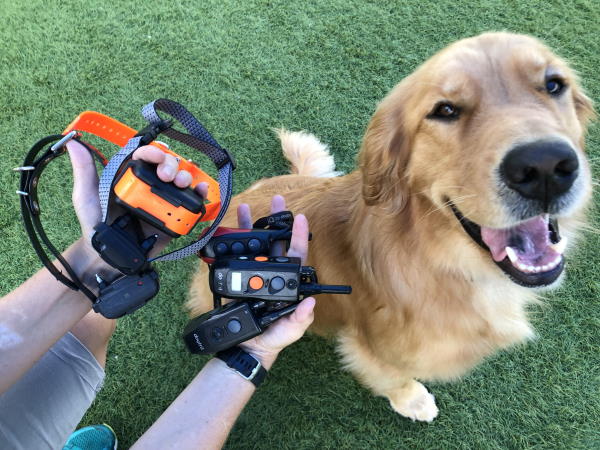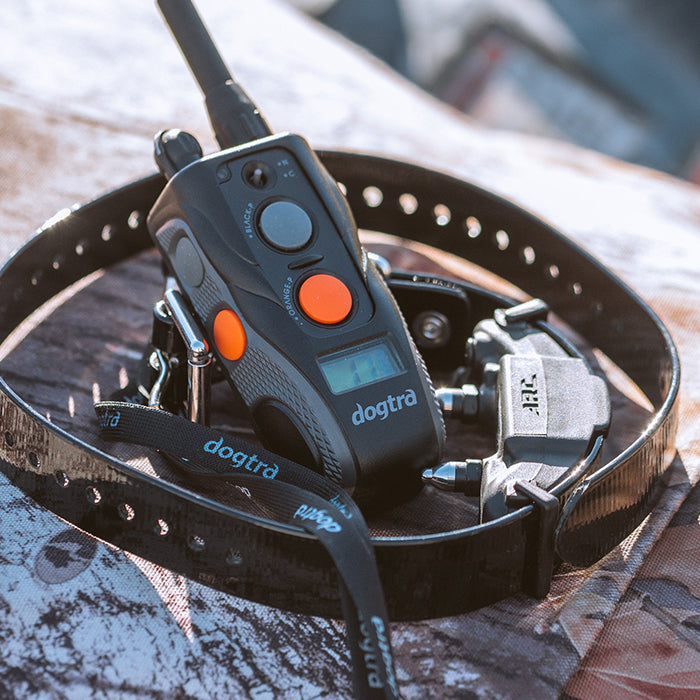CHOOSING THE RIGHT E-COLLAR FOR DOGS: A BEGINNER'S GUIDE

When you’re looking to purchase a remote training collar, there are many makes and models to choose from. Trying to decide on the best e-collar for dogs may be a bit overwhelming, particularly if it is your first purchase.
Before you spend hours researching all the options available, here are a few considerations to help you narrow the choices and select the obedience equipment best suited to your dog’s needs as well as your own.
What is an E-Collar and How Does it Work?
An e-collar, also known as an electronic collar or a remote training collar, is a device designed for dog training. It consists of a collar with a receiver that fits around your dog's neck and a remote control. The remote control sends signals to the receiver to trigger different levels of electrical stimulation to the dog's neck. The stimulation is intended to get your dog's attention or provide feedback during training.
Can Shock Collars Hurt Your Dog?
The use of e-collars, particularly shock collars, has been a topic of controversy in the dog training world. While the stimulation from an e-collar can be uncomfortable, it is not designed to cause pain or injury to your dog. Reputable e-collars are designed with safety features to prevent over-stimulation or accidental activation. However, it is crucial to use the e-collar properly and follow the manufacturer's instructions to ensure your dog's safety and well-being. Additionally, some dogs may be more sensitive to electrical stimulation, and it is essential to monitor your dog's behavior and response to the collar during training.
How to Choose the Right E-Collar for Your Dog
Choosing the right e-collar for dogs can be a daunting task, with so many options available on the market. Remote collars are a popular tool used for dog training and can be an effective way to train your dog, but selecting the right one for your dog can make all the difference. Here is what you need to know when choosing an e-collar.
Consider the Environment & Situations Your Dog Will Face
Start out by thinking about the situations and environments you will be taking your dog into. Be sure to consider not only the most pressing reason guiding this purchase but also contemplate what you would do or where you would go with your dog IF you had better obedience and improved control. For instance, if you’re buying an e-collar because your dog tends to bolt and run off, ask yourself what opportunities you’ll take advantage of once a solid recall is achieved. Will you be more likely to take your dog off-leash hiking or to the beach? Do you currently hunt with your dog or hope to?
If you answered yes to any of the questions above, it is important to know that wooded or undulating terrain will affect the actual range capability of a remote collar. When manufacturers state the distance an e-collar will reach, they are referring to a straight, flat, line-of-sight terrain. Any obstruction, like trees or a hilly landscape, will diminish the range to some extent. This includes walls and windows, so if you want the ability to interrupt barking while your dog is outside or in another part of the house, consider the range of your collar. Plus, it doesn’t take a fast dog very long to get out of sight and more than 100 yards away when hot on the trail of a critter!
It is also wise to consider if waterproof components will be important to your lifestyle. Most receivers (the collar or part the dog wears) are waterproof nowadays, but not all transmitters (the remote or part that you hold in your hand) are. Even if you don’t intend to take your dog swimming, consider if you’ll be in any rainy or wet conditions together. For the minimal amount of cost difference, it is nice to have a waterproof e-collar that allows you and your dog to fully enjoy the freedom of a remote collar.
Evaluate Your Dog’s Sensitivity to Physical Stimulation
The next step is to evaluate the dog’s sensitivity to physical stimuli. This needs to be done unemotionally, which can be challenging if you are struggling to solve a behavior problem. Too often, frustration causes us to label a dog as “stubborn,” attributing some conscious act of willfulness to the dog’s behavior. The vast majority of the time, this isn’t the case, and the dog’s perceived stubbornness is actually just a lack of good training. Instead of assuming you have a stubborn dog and drawing a conclusion that equates to needing a high-powered remote collar, ask yourself how physically sensitive your dog is.
Sensitivity to physical stimuli will help you determine if you need a low-to-medium vs. low-to-high powered collar. Consider whether or not your dog is affected by physical sensations when he is in a high state of excitement. For instance, if your dog was chasing a rabbit, would he charge without much hesitation into a thicket of thorny bushes? Or would he stop short? If your dog is in hot pursuit of a tennis ball, does he crash over things or jump head-first into the frigid water to retrieve it? These sorts of behaviors provide an indication of how easily Fido may (or may not) notice physical sensations when he’s aroused. It is during those times of high arousal that you have the right collar for your dog. There is nothing wrong with simply purchasing a low-to-high powered collar to ensure you have enough, but if you have a pretty sensitive dog, then there isn’t a reason to add the additional expense.
Pick E-Colar that Fits Your Dog’s Size & Breed
Choosing an E-Colar that fits your dog's size and breed requires careful consideration of several factors. First, determine your dog's size and weight to ensure that you choose an E-Colar that is appropriate for their build. Next, consider the type of stimulation offered by the E-Colar, as some collars use static shock, while others use vibration or sound. It's important to choose a collar with a stimulation level that is appropriate for your dog's temperament and sensitivity.
Additionally, look for an E-Colar with adjustable features, such as the collar size, contact points, and stimulation levels, to ensure a comfortable and customized fit for your dog's specific breed and body shape. Finally, choose an E-Colar with a reputable brand and manufacturer that offers clear instructions and guidance on how to use the collar safely and effectively. By considering these factors, you can select an E-Colar that fits your dog's size and breed while also meeting their unique training and safety needs.
Check Ratings & Warranty
Once you have chosen a collar suited to your dog and the options best suited for your purpose and lifestyle, look at the warranties and reputation of the manufacturer.
A remote collar isn’t a one-and-done type of tool. You’ll be using it not only for training but also as an invisible leash that your dog wears when you’re out and about. A good e-collar can last you many years and be worn by generations of dogs. It pays off to invest in a high-quality piece of equipment, so spend what your budget can afford to ensure a long-term gain from your purchase.
Conclusion
Finally, if you are new to using a remote collar, purchasing the right equipment is only the first step in your homework. Once you’ve selected your collar, take time to familiarize yourself with the equipment and research training techniques and best practices before you begin using it on your dog.
Remote collars are tools that can bring great finesse and wonderful results to your training but they aren’t necessarily intuitive if you haven’t used one before. Here is some helpful training information to get you on your way to a fun and improved relationship with your canine friend.
Happy Training!




